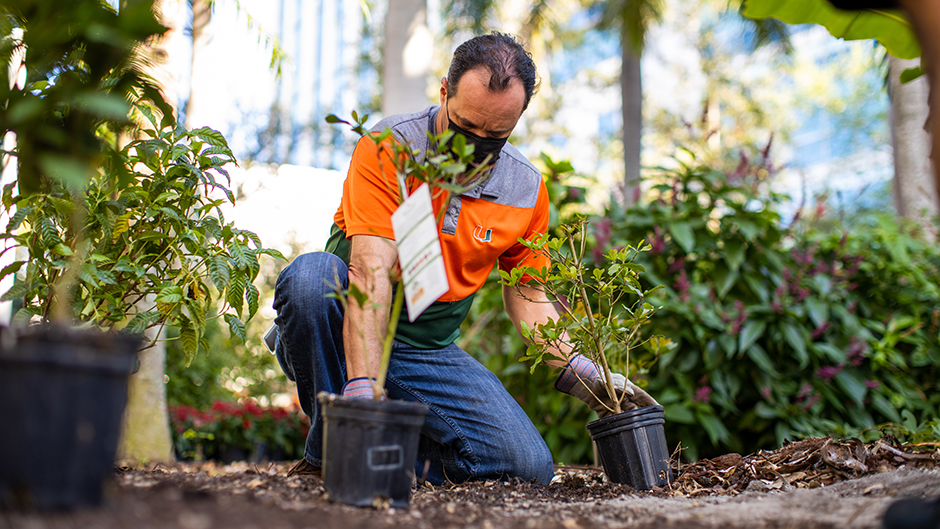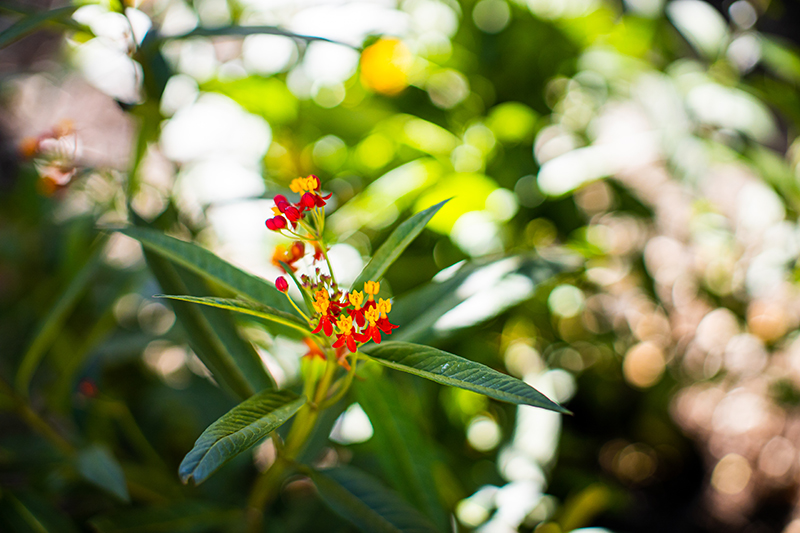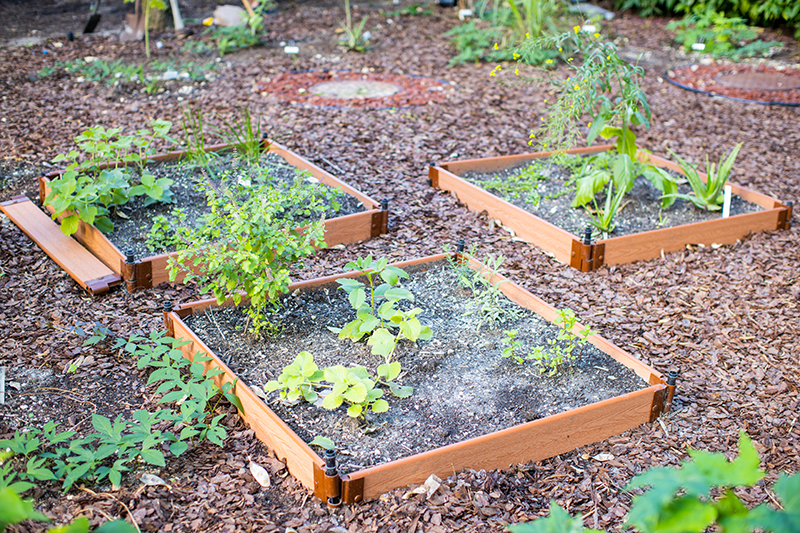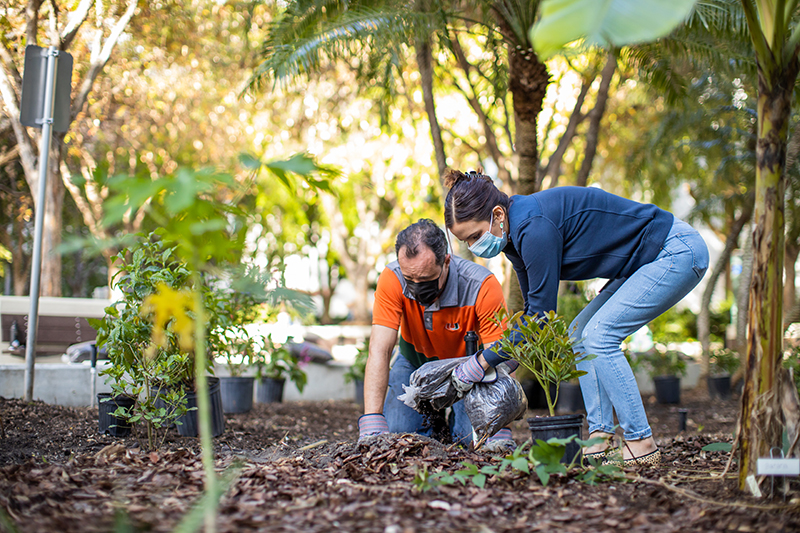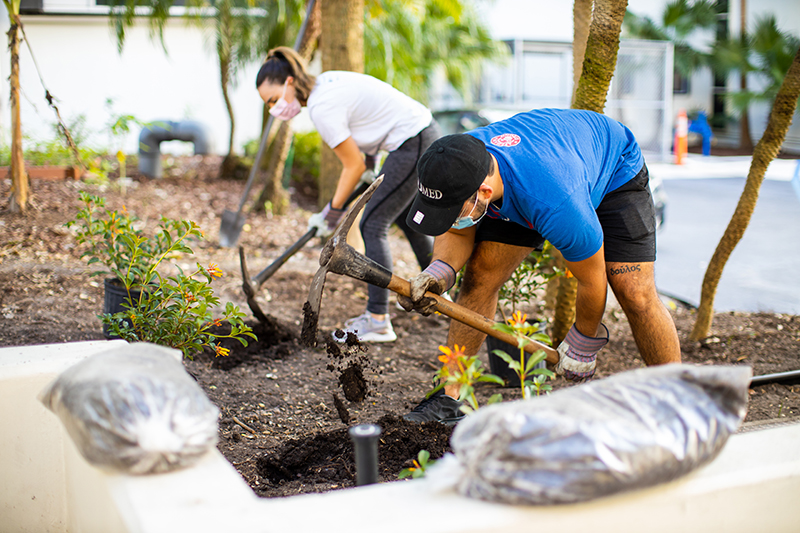How would you like to step out of your office building or health care facility into the sunshine to be greeted by a flourishing garden? At the University of Miami’s Miller School of Medicine, that is now a reality.
Working with Dr. Christina Pozo-Kaderman, director of clinical operations at Sylvester’s Cancer Support Services, medical students, and dietitians, the Facilities and Operations Department, and the Office of Sustainability have helped create an oasis of healing and support for the Cancer Support Services mission.
For many people, being in nature is a great way to de-stress and can even be part of a healing process. At the Sylvester Comprehensive Cancer Center, patients and staff members alike now have the opportunity to visit and cultivate a garden created for health, healing, and personal growth.

A culmination of years of effort and collaboration between various departments, the Miller Herb and Food Garden started in 2018 with the butterfly garden planted behind the Professional Arts Center. The area contains plants with medicinal properties, including familiar ones like turmeric, mint, ginger, and aloe vera.
The garden provides an opportunity for these plants to be used to create community and support for cancer patients and their families throughout their treatment and afterward. Physical and mental health therapy staff members and dietitians on the Cancer Support Services team hope to foster a wide array of uses for the garden. This includes using herbs during cooking demonstrations, which patients can incorporate into their daily lives and even with meditation and mindfulness.
“Gardening lends itself well to mindfulness and meditation,” said Dr. Pozo-Kaderman. “I think the garden will be therapeutic for the patients on so many levels. It’s the connection to the place that is healing for them and being able to plant something; and so, a part of them is there. Patients feel they are a part of the Medical Campus, can bond with each other, and give back.”
The Sylvester’s Cancer Support Services offers services like nutrition counseling, exercise physiology and yoga, pastoral care, acupuncture, massage therapy, pet therapy, and an Arts in Medicine program.
The Arts in Medicine program, led by Leah Andritsch, artist in health and University alumna, encourages patients to use creative expression to “help reduce feelings of anxiety, boost morale, and support wellness” as they go through treatment and beyond. “The garden is an opportunity to engage in some of these well-being modalities, such as gardening, mindfulness in nature, and using the incorporation of plants for creative activities,” said Andritsch.
Offering highly nutritious foods and herbs that are free and accessible to all will help with the success of patients’ treatment plans. Lourdes Lopez, first year medical student and one of several who helped to plant the garden, discussed the importance of a nutritious diet for the success of treatment. “Gardens in health care can potentially become a convenient way for patients to access certain foods, all while eliminating financial barriers,” noted Lopez.
Food deserts and socioeconomic status have a huge impact on the kinds of food available for patients, depending on where they live. “A person’s ZIP code often determines what kind of food, transport, or opportunities for physical activity one can access,” said Mathilde Hainaut, a medical and public health student. “Having a community garden available near treatment facilities not only provides healthy food options for individuals in need, but also encourages community interaction and engagement, which I believe is particularly important during this pandemic where social isolation has been exacerbated.”
“The Miller School of Medicine places a huge emphasis on student wellness and this project will give yet another opportunity for students (and visitors) to get outside, get some fresh air, and de-stress,” said Adam Levy, president of the Miller School’s Student Green Committee and first-year M.D./M.B.A. student. Levy was one of several volunteers who planted the foundations of this herb and food garden.
 As the project grows, we hope students will use the garden as a space to relax while on campus,” added Levy. “The garden is strategically bordered by beautiful pollinator-friendly plants, attracting a variety of butterflies and even hummingbirds!”
As the project grows, we hope students will use the garden as a space to relax while on campus,” added Levy. “The garden is strategically bordered by beautiful pollinator-friendly plants, attracting a variety of butterflies and even hummingbirds!”
Volunteers recently planted a generous donation of Miracle Fruit shrubs, which has berries that help enhance the flavors of any foods eaten, immediately after the berries are consumed. For patients who have lost their appetites because of the effects of chemotherapy on their palates, the ability to experience flavor again reignites their interest in food and eating.
Frances Kaniewski, director of Facilities and Operations at the Miller School, and Teddy Lhoutellier, sustainability manager for the University, helped coordinate the project. “I hope the garden will grow and serve many patients, staff members, students, and visitors in the future,” said Lhoutellier. “We gathered the mind power and elbow grease of various departments to create something different. The concept of food forest is the same one we applied in the Sustainability Garden on the Coral Gables Campus.” added Lhoutellier. “In a few months, when seedlings become shrubs and bushes, we hope that the experience of the visitor will be like entering a miniature forest, but with fruits, vegetables, and herbs that can be harvested.”
Located in front of the Louis Calder Memorial Library, the Miller Herb and Food Garden is one of several sustainable gardens and initiatives at the University of Miami. It is open to all and easily accessible. Visit miami.edu/gardens or send an email to greenu@miami.edu to learn more about how to get involved.
